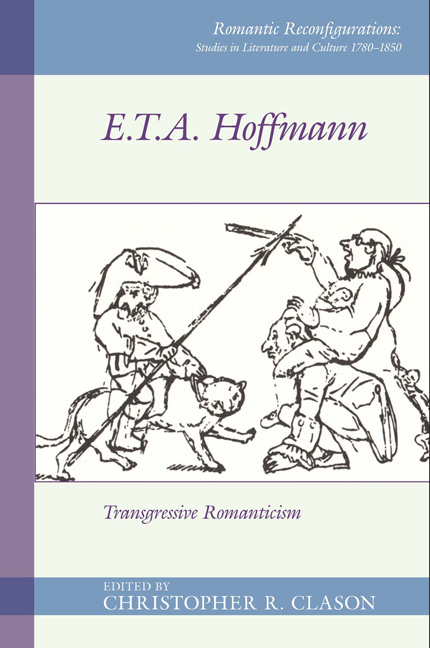Book contents
- Frontmatter
- Contents
- List of Figures
- Acknowledgements
- Notes on Contributors
- Introduction
- I Transgression and Institutions
- II Transgression and the Arts
- 4 E.T.A. Hoffmann and the Bamberg Theater
- 5 Transitions and Slippages of Mimesis in E.T.A. Hoffmann's “Der goldene Topf,” “Die Fermate,” and “Das öde Haus”
- 6 Transgressions: On the (De-)Figuration of the Vampire in E.T.A. Hoffmann's “Vampyrismus”
- III Transgression in the Märchen
- IV Transgression of Reception in Kater Murr
- Works Cited
- Index
6 - Transgressions: On the (De-)Figuration of the Vampire in E.T.A. Hoffmann's “Vampyrismus”
from II - Transgression and the Arts
- Frontmatter
- Contents
- List of Figures
- Acknowledgements
- Notes on Contributors
- Introduction
- I Transgression and Institutions
- II Transgression and the Arts
- 4 E.T.A. Hoffmann and the Bamberg Theater
- 5 Transitions and Slippages of Mimesis in E.T.A. Hoffmann's “Der goldene Topf,” “Die Fermate,” and “Das öde Haus”
- 6 Transgressions: On the (De-)Figuration of the Vampire in E.T.A. Hoffmann's “Vampyrismus”
- III Transgression in the Märchen
- IV Transgression of Reception in Kater Murr
- Works Cited
- Index
Summary
Cyprian's “horrific story” from E.T.A. Hoffmann's collection Die Serapions- Brüder (The Serapion-Brothers, 4 vols. [1819–21]) offers one of the first literary adaptations of the vampire motif in the German language. Later editors supplied the title “[Vampyrismus]” (“[Vampyrism]”) for the story, owing to the conversation about vampires and Gothic literature that the “Serapion Brothers,” Lothar, Theodor, Vinzenz, Sylvester, Ottmar, and Cyprian, hold in the volume's framing fiction. Surprisingly, the strange tale that occurs to Cyprian because of this discussion does not contain any vampire figure per se: there is no “cursed character who gets buried as a dead thing and soon rises from the grave and drinks people's blood while they sleep,” as the framing conversation suggests. Instead, the story's main characters, a baroness and her beautiful daughter Aurelie, increasingly assimilate themselves to the realm of the dead on account of their necrophagic tendencies. This introduces a striking, almost chiastic tension between the framing narrative and the embedded story: the former concerns the living dead, who drink the blood of the living, while the latter has to do with living persons who feed on corpses. Why does Hoffmann build up the promise of a vampire story so emphatically, only then blatantly not to present the reader with a single undead figure? The topic would have fit his interest in the uncanny and the fantastic well – one thinks, for example, of his Ignaz Denner, who drinks the blood of his children and his children's children in Nachtstücke (Night Pieces, 1816) or the murderous Medardus in Hoffmann's Gothic novel Die Elixiere des Teufels (The Devil's Elixirs, 2 vols., 1815–16) whose uncanny Doppelgänger craves to drink blood. It would appear that the figure of the vampire cannot be reconciled with the “Serapiontic Principle” as it is developed over the course of the Serapions-Brüder collection. The inverse relation between Cyprian's tale and the conversation that frames it suggests instead that, through its association with vampirism, the Serapiontic Principle transforms into its abyssal opposite. The figure of the vampire emerges as the dark, aporetic flipside of Serapiontic poetics.
- Type
- Chapter
- Information
- E. T. A. HoffmannTransgressive Romanticism, pp. 114 - 132Publisher: Liverpool University PressPrint publication year: 2018



